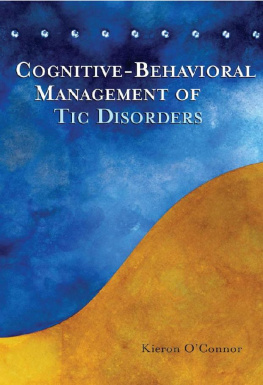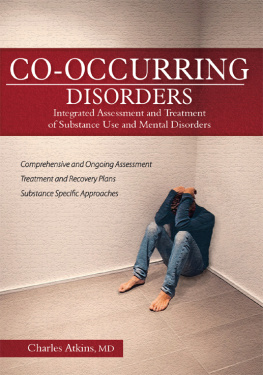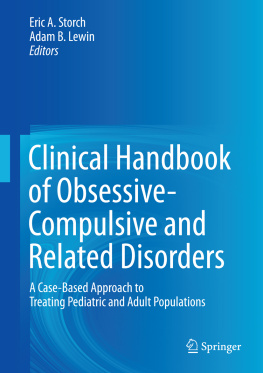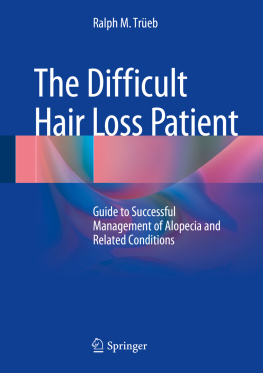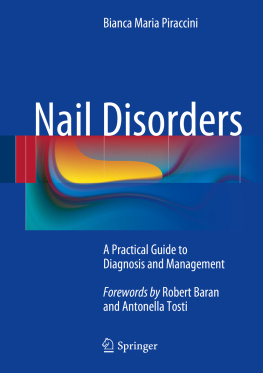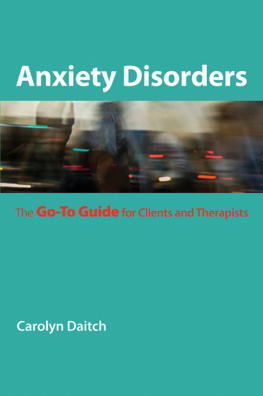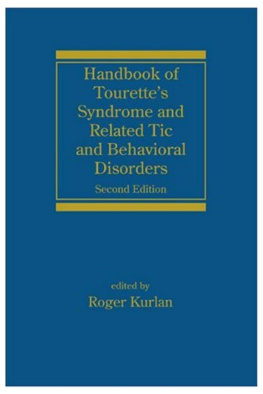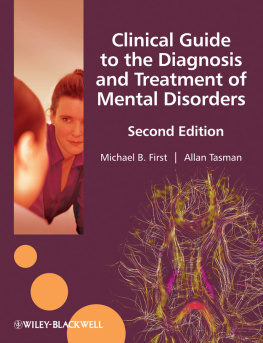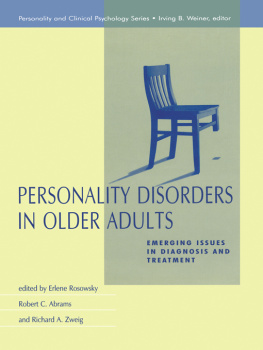COGNITIVE-BEHAVIORAL MANAGEMENT OF TIC DISORDERS
Kieron OConnor
Fernand-Seguin Research Centre, Louis-H. Lafontaine Hospital, Department of Psychiatry, University of Montreal, Quebec
ABOUT THE AUTHOR
Kieron OConnor began his research career working as a research officer at the Medical Research Council (UK) Clinical Psychiatry Unit at Graylingwell Hospital, Chichester, Sussex. In 1979, he was awarded a Master of Philosophy (MPhil) by thesis in experimental psychology from the University of Sussex, and in 1984 a doc-torate degree (PhD) in research psychology at the Institute of Psychiatry, University of London. He completed the British Psychology Society clinical diploma training course in 1986, and transferred to the University College, Institute of Laryngology and Otology, working partly as a research lecturer, investigating psychological aspects of vertigo and dizziness, and also as a clinical psychologist at Bloomsbury Health Authority.
In 1988, he was awarded the first of a series of fellowships by the Fonds de la Recherche en Sant du Qubec, and established a clinical research program at the Fernand-Seguin Research Center, Louis-H. Lafontaine Hospital, University of Montreal, Canada. The multidisciplinary research program, which focuses on obsessive-compulsive disorder (OCD), Tourette and tic disorder and delusional disorder, is currently funded by the Canadian Institutes of Health Research. He is actively involved in several community-based initiatives to provide support and information to people with OCD and Tourettes syndrome and their families, and is scientific advisor to the Quebec OCD Foundation.
He is currently associate research professor at the Psychiatry Department of University of Montreal, and also holds an honorary cross appointment as associate professor in the Department of Psychology, University of Quebec at Montreal. He is author or co-author on over 100 scientific publications. He is also co-author with Frederick Aardema and Marie-Claude Pelissier of Beyond Reasonable Doubt: Reason-ing Processes in OCD Disorder and Related Disorders , published in 2005 by Wiley.
PREFACE
The focus in this text is on cognitive-behavioral approaches and related psychoedu-cational and psychophysiological methods, to aid the management of tics in people with Gilles de la Tourettes syndrome and chronic tic disorder. The initial section of the book reviews the relevant literature and research work in this area. The middle section presents a cognitivepsychophysiological model of tics, together with an outline of empirical studies testing the model. The final section and appendices provide a therapist and client manual for use in tic management, with four case illustrations.
Cognitive-behavior therapy (CBT) will probably be familiar to professional and non-professional readers alike as a recently developed evidence-based psychological intervention that has been successfully applied to anxiety, affective and, lately, psychotic disorders. In practice, the CBT approach often complements other more medical approaches, but it nonetheless follows a distinct case conceptualization of psychiatric disorder based on CBT principles. It views symptoms as behavior, actively maintained by thought and behavior patterns in the here and now, rather than as the result of more remote hypothetical intrapsychic processes. Consequently, treatment follows a learning model, where control over symptoms depends on the active collaboration of the client in successful acquisition and application of new ways of thinking and behaving. In this tradition, behavioral and learning principles have been applied in several recent attempts to understand and treat tic and habit disorders. The term habit disorder has an uncertain diagnostic status in psychiatric nosology, but covers a range of usually manual habits such as nail biting, skin picking, scratching, rubbing, hair pulling, teeth grinding, neck and knuckle cracking.
A habit disorder generally seems to be under some degree of voluntary control but which the person, nonetheless, is unable to stop, unlike tics which appear more like neurological reflexes. There is debate as to whether tics and habits form a continuum. However, habit disorders, in particular trichotillomania, have already formed the subject of a number of comprehensive manualized CBT treatments emphasizing, in addition to behavioral control, the emotional, interpersonal and cognitive dimensions of the habitual behavior (e.g., Mansuetto et al., 1999). There is a less extensive CBT literature on treating tics, but tics as found in Tourettes syndrome and other tic disorders have, however, formed the target for a behavioral approach termed habit reversal (Azrin & Nunn, 1973; Woods & Miltenberger, 2001). There is a growing body of clinical evidence supporting the effectiveness of habit reversal in reducing tics, but there have been few large-scale studies of its efficacy, and since habit reversal is a multicomponent program, it is unclear which are its crucial
xii PREFACE
elements. Also, habit reversal procedures are inspired by behavioral principles rather than a specific model of tic phenomenology. But tics are not just conditioned responses. Consequently, the clinical success of behavior therapy has not been accompanied by an improved and more comprehensive cognitive-behavioral conceptualization of tic maintenance or genesis. Also, the habit reversal view of tics as isolated behavioral events, and the failure to explicitly address cognitive variables, can limit its consideration of the wider everyday cognitive-behavioral context relevant to tic management.
The gap between behavior and cognition is, to some extent, an artificial one, and even in a strictly behavioral approach, the clients must understand the model, and articulate their motivation and reasons for changing the habit and be able mentally to link cause and effect in their application of techniques. Although seldom explicitly measured, it is clear from case studies reporting behavior therapy for tics that, as in other psychiatric disorders, behavioral change can be accompanied by a change in thinking about the disorder. However, in our own work, we realized that cognitive factors were not only a useful adjunct to behavior therapy but were often central to the occurrence of the tic. For example, anticipation can provoke tics or even just thinking about ticcing can provoke tics, and negative evaluation of high-risk situations can lead to increased levels of tension and ticcing.
Previous models of tics have focused either on the role of central brain structures or on localized social or behavioral operants reinforcing the tic, but there is also a vast and largely untapped literature on the intermediate processes between brain and behavior relating to the psychology and psychophysiology of motor behavior. Motor psychophysiology can shed light on how central commands control the intri-cacies of preparation and muscle tension, and how such preparation and tension can produce unwanted voluntary and involuntary movements. This approach views cognition and behavior, voluntary and non-voluntary action as different stages in the same motor action sequence. Thought-action, cognitive-motor coupling can be accommodated by a cognitivepsychophysiological model which takes account of forward planning and feedback correction as a part of motor control, and views even non-voluntary actions as occurring against a background behavioral action plan.
As the motor theorist Bernstein (1967) pointed out, no individual contraction can be considered independent of the wider intentional actions of the motor program, and this motor program, in turn, has to be understood in terms of an ecological adaptation to the environment. Hence, it may be towards the overall telic activity of the person that we need to look for clues about tic onset rather than to just neurobiological structures or situational operants. The cognitivepsychophysiological model led to the development of a CBT approach that, although complementing and building on previous behavioral interventions, placed cognitive factors cen-ter stage. In effect, isolated habit reversal strategies are integrated into a wider cognitive-motor restructuring of behavior preceding tic onset in order to prevent the tic occurrence rather than resist it once it has appeared. Inevitably, such cognitive and motor restructuring addresses the wider behavioral context surrounding the persons style of action.
Next page
